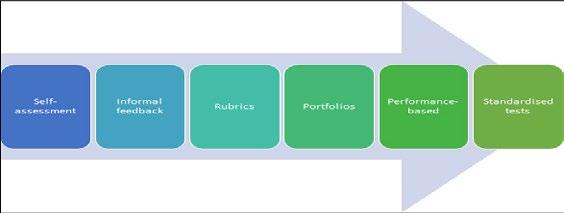
4 minute read
What do I need to know about students and why?
Figure 3. Assessment for Learning Continuum (Adapted from Stefanakis, 2002 as cited in Finger et al. (2007)
What do I need to know about students and why?
Advertisement
In order for you to plan appropriate learning experiences it is essential that you maintain a reasonable amount of information relating to the composition of ICT capability. In other words, every component that constitutes ICT capability – routines, techniques, concepts, processes and higher order skills – needs to be assessed individually in order for you to ensure progression and continuity of student capabilities.
The best way to assess a child’s ICT capability is by monitoring and observing these components and using different strategies for each of them.
Techniques
For this component, it is best to demonstrate them either in a whole-class or small group setting. The reason is that you want to know if a student can perform a technique after such a discussion. For example, when demonstrating how to use a bee bot I went through and discussed with the whole class how to do so and then I divided them into smaller groups and briefly went over it again. Then I allowed the student to undertake the task themselves.
In this situation, it is ideal to have a method for you to be able to record their ICT skills in order for you to keep track of which students are confident in using the technique. It is important to remember to provide the minimum amount of support to students who need help and that this support to be withdrawn as

Routines
Routines are techniques being done without any conscious thought and they are recognised by the ease and speed with which familiar techniques are executed. For example, while assessing student techniques when using a bee bot, I included three columns that would let me know if a student was hesitant, steady or fluent. I then used this information to plan opportunities to move student from hesitant to steady or steady to fluent in a technique. All my judgements were obviously based on observation.
It is a good idea to have for each age group a brief checklist of techniques that the students will be able to use routinely.
Concepts
As discussed earlier, conceptual understanding forms an integral part of ICT capability. You would need to know then if a student has any misconceptions and this can be achieved by using an error analysis technique. In other words, note down any mistakes or misconceptions and further check for understanding using effective questioning and discussion.
Processes
When a student is able to carry out a process then they are also capable of making decisions. This is part of their higher order skills and can be judged on the extent to which scaffolding was necessary. According to Kennewell et al. (2000, p95), “an understanding of relevant concepts is needed order to analyse a situation and identify the particular techniques required to reach the desired goal.” Therefore, a simple checklist or tick box is not appropriate and you would need to know, for example, if a student was able to make a decision about:
1. Which media to combine, and in what way, in order to present some particular information to a specific audience; 2. Which series of techniques to use in order to follow a line of enquiry to prove or disprove an hypothesis; 3. Which techniques to use in a graphics program in order to produce a portrait that visually represents feelings?
This type of information would help you to ensure that students understand the concept of ‘audience’ and not just being able to use techniques like adding text, graphics or sound to a page.
If you intend to asses a process, then you will need to focus on a group and observe how they can execute a task. You may need to at times intervene and ask key questions.
Children’s ability to self-assess learning
Self-assessment provides opportunities for children to learn critical life skills such as self-motivation and positive self-esteem. These two are essential if you are to enable children to make confident self-assessments. Through taking part in exciting and motivating problem-solving tasks you can support them in this personal skill and encourage them to use their own initiative and to make personal decisions.
It is important that children consider in their process of self-reflection, the following:
• What interests me? • What do I enjoy doing? • What do I want to be able to do? • What helps me to learn? • What would I like to know?
This gives them the opportunity to reflect on their learning and contribute their ideas.
Self-assessment in early childhood is important because:
• Enables children to have an element of control over their own learning environment; • Gives children a sense of responsibility and self-esteem; • Gives opportunities for real-life problem-solving





